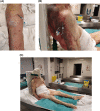Randomized Controlled Study of a Training Program for Knee and Shoulder Arthrocentesis on Procedural Simulators with Assessment on Cadavers
- PMID: 34989181
- PMCID: PMC8992473
- DOI: 10.1002/acr2.11400
Randomized Controlled Study of a Training Program for Knee and Shoulder Arthrocentesis on Procedural Simulators with Assessment on Cadavers
Abstract
Objective: The study objective was to assess the efficacy of simulators in improving the competence of students in performing a knee and shoulder arthrocentesis on cadavers and to determine the minimum number of simulator training procedures needed to achieve competence in arthrocentesis.
Methods: Two groups of 15 medical students were each trained to perform a single joint arthrocentesis ("knee group" and "shoulder group") on a simulator to serve as a control for the other. The two groups received the same theoretical training (anatomy, arthrocentesis techniques, ultrasound, and hybrid simulation). Each student punctured the two joints on a cadaver. A student was considered "competent on the cadaver" if they succeeded at two or more arthrocentesis procedures out of the three tests on the joint on which they were trained. The minimum threshold value to be competent was calculated by a receiver operating characteristic curve and the Youden index. An assessment of theoretical knowledge and confidence level in joint arthrocentesis was carried out at the start and end of the study.
Results: Twenty-two out of 29 students (75.8%) achieved competence in arthrocentesis at the joint for which they were trained. Of the students in the knee group, 79% were competent on the cadaver's knee versus 60% of the students in the shoulder group (P = 0.43). Of students in the shoulder group, 74% were competent on the cadaver's shoulder versus 57% of students in the knee group (P = 0.45). Four training punctures on a simulator are necessary to achieve competence on a cadaver. The students' confidence level in arthrocentesis increased significantly during the study, as did the students' theoretical knowledge.
Conclusion: Knee and shoulder arthrocentesis success rates were not statistically different between the two training groups. A minimum number of 4.0 training arthrocentesis on a simulator is needed to achieve competency on a cadaver.
© 2022 The Authors. ACR Open Rheumatology published by Wiley Periodicals LLC on behalf of American College of Rheumatology.
Figures



References
-
- Sterrett AG, Bateman H, Guthrie J, Rehman A, Osting V, Carter JD, et al. Virtual rheumatology: using simulators and a formal workshop to teach medical students, internal medicine residents, and rheumatology subspecialty residents arthrocentesis. J Clin Rheumatol 2011;17:121–3. - PubMed
-
- Lynch TS, Hellwinkel JE, Jobin CM, Levine WN. Curriculum reform and new technology to fill the void of musculoskeletal education in medical school curriculum. J Am Acad Orthop Surg 2020;28:945–52. - PubMed
LinkOut - more resources
Full Text Sources

